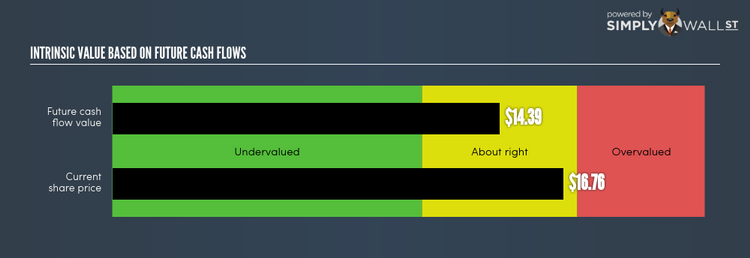United Financial Bancorp Inc (NASDAQ:UBNK) Investors Are Paying Above The Intrinsic Value

Pricing bank stocks such as UBNK is particularly challenging. Given that these companies adhere to a different set of rules relative to other companies, their cash flows should also be valued differently. For instance, these lenders must hold a certain level of cash reserves on the books as a safety precaution. Looking at line items such as book values, with the return and cost of equity, is fitting for computing UBNK’s intrinsic value. Today I’ll look at how to value UBNK in a reasonably useful and easy approach. See our latest analysis for United Financial Bancorp
Why Excess Return Model?
There are two facets to consider: regulation and type of assets. Strict regulatory environment in United States’s finance industry reduces UBNK’s financial flexibility. In addition to this, mortgage and thrift companies usually do not possess significant portions of physical assets as part of total assets. The Excess Returns model overcomes the required capital kept on hand and lack of tangibles by focusing on forecasting stable earnings, rather than less relevant factors such as depreciation and capex, which more traditional models focus on.
Deriving UBNK’s True Value
The central belief for Excess Returns is that equity value is how much the firm can earn, over and above its cost of equity, given the level of equity it has in the company at the moment. The returns above the cost of equity is known as excess returns:
Excess Return Per Share = (Stable Return On Equity – Cost Of Equity) (Book Value Of Equity Per Share)
= (9.18% – 9.30%) * $14.64 = $-0.02
We use this value to calculate the terminal value of the company, which is how much we expect the company to continue to earn every year, forever. This is a common component of discounted cash flow models:
Terminal Value Per Share = Excess Return Per Share / (Cost of Equity – Expected Growth Rate)
= $-0.02 / (9.30% – 2.47%) = $-0.25
These factors are combined to calculate the true value of UBNK’s stock:
Value Per Share = Book Value of Equity Per Share + Terminal Value Per Share
= $14.64 + $-0.25 = $14.39
Compared to the current share price of $16.76, UBNK is , at this time, priced in-line with its intrinsic value. This means UBNK isn’t an attractive buy right now. Pricing is one part of the analysis of your potential investment in UBNK. There are other important factors to keep in mind when assessing whether UBNK is the right investment in your portfolio.
Next Steps:
For mortgage and thrift companies, there are three key aspects you should look at:
Financial health: Does it have a healthy balance sheet? Take a look at our free bank analysis with six simple checks on things like bad loans and customer deposits.
Future earnings: What does the market think of UBNK going forward? Our analyst growth expectation chart helps visualize UBNK’s growth potential over the upcoming years.
Dividends: Most people buy financial stocks for their healthy and stable dividends. Check out whether UBNK is a dividend Rockstar with our historical and future dividend analysis.
For more details and sources, take a look at our full calculation on UBNK here.
To help readers see pass the short term volatility of the financial market, we aim to bring you a long-term focused research analysis purely driven by fundamental data. Note that our analysis does not factor in the latest price sensitive company announcements.
The author is an independent contributor and at the time of publication had no position in the stocks mentioned.

